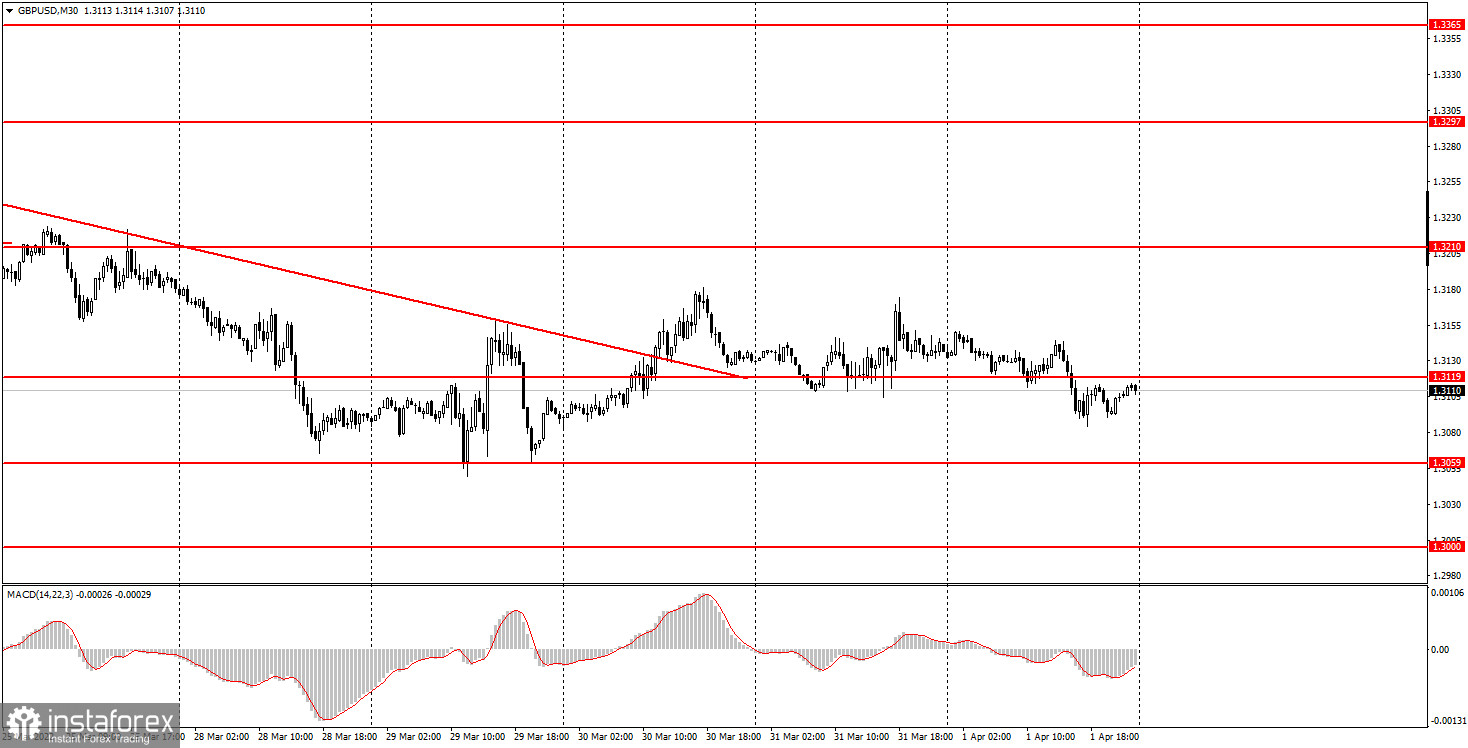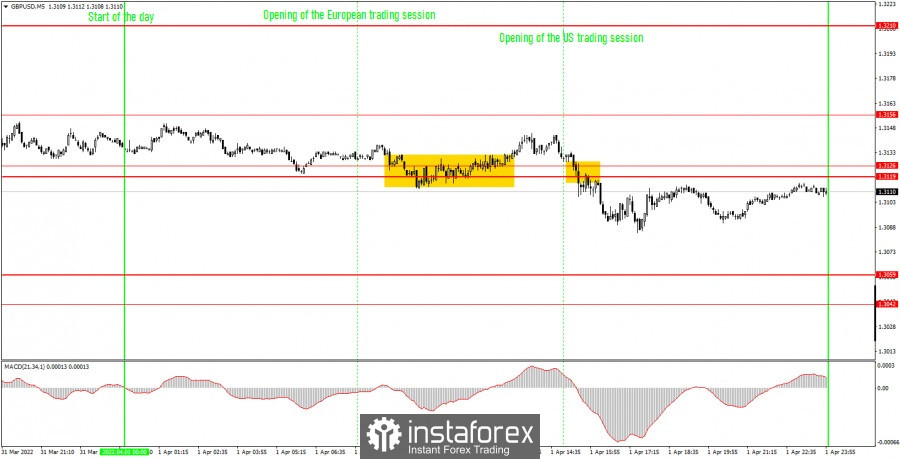Analysis of previous deals:
30M chart of the GBP/USD pair

The GBP/USD pair was also trading very sluggishly on Friday, having managed to pass 66 points for the whole day. Same downward bias as the euro/dollar pair. The same indistinct movement. Now it is not even possible to determine the trend, since the pound seems to be declining, but at the same time it is doing it somehow too sluggishly and reluctantly. The main problem, of course, is the reduced volatility. Over the past two months, traders have become accustomed to the fact that the pair regularly travels significant distances. But in the last few days, volatility is low, which is not conducive to making profits in the foreign exchange market. We have already talked about inflation in the EU, but the report on Nonfarm in the US was even more important. Recall that NonFarm Payrolls is one of the most important events in the foreign exchange market and usually there is a reaction to it, even if the value itself is neutral. However, this time, with 431,000 new jobs created outside the agricultural sector, which is less than forecast, but overall a very decent value, there was no reaction at all. After this report was published, and with the US unemployment rate falling to 3.6%, the dollar rose by a high of 30 points, which was more likely not a market reaction, but its usual movement.
5M chart of the GBP/USD pair

The movement on the 5-minute timeframe looks a little better for the euro/dollar pair, but this did not change anything for the better. Only two trading signals were formed during the day, and this is very good, since there could be a much larger number, but at the same time, the percentage of false signals could be much higher. The first buy signal was formed when the price rebounded from the 1.3119-1.3126 area. This signal was formed for 4.5 hours, so it is hard to call it strong. After its formation, the pair went up 10 points... The second signal to sell was formed on overcoming the area of 1.3119-1.3126, but exactly at the time when the US report was published. So it wasn't worth the risk. As a result, novice traders could get a small loss on a single open transaction, but this is not scary - every open transaction in the market cannot be profitable.
How to trade on Monday:
The pair's downward trend has been reversed on the 30-minute timeframe, but a new upward trend has not been formed. The British pound is still at risk due to complex geopolitics and may continue to slide down. At the same time, there is no blatant and new negative now, so a flat on the higher timeframe is possible, which will look not too strong on the lower timeframe - "swing": two days down, three up, three down. On the 5-minute TF tomorrow it is recommended to trade at the levels of 1.3000, 1.3042, 1.3059, 1.3119-1.3126, 1.3156, 1.3210. When the price passes after opening a deal in the right direction for 20 points, Stop Loss should be set to breakeven. There are no major events planned for tomorrow in the UK and America. Therefore, beginners will have nothing to pay attention to during the day. Unless new data suddenly arrives from Ukraine or Russia, but recently the conflict has entered a sluggish phase, so we don't expect any fresh news.
Basic rules of the trading system:
1) The signal strength is calculated by the time it took to form the signal (bounce or overcome the level). The less time it took, the stronger the signal.
2) If two or more deals were opened near a certain level based on false signals (which did not trigger Take Profit or the nearest target level), then all subsequent signals from this level should be ignored.
3) In a flat, any pair can form a lot of false signals or not form them at all. But in any case, at the first signs of a flat, it is better to stop trading.
4) Trade deals are opened in the time period between the beginning of the European session and until the middle of the American one, when all deals must be closed manually.
5) On the 30-minute TF, using signals from the MACD indicator, you can trade only if there is good volatility and a trend, which is confirmed by a trend line or a trend channel.
6) If two levels are located too close to each other (from 5 to 15 points), then they should be considered as an area of support or resistance.
On the chart:
Support and Resistance Levels are the Levels that serve as targets when buying or selling the pair. You can place Take Profit near these levels.
Red lines are the channels or trend lines that display the current trend and show in which direction it is better to trade now.
The MACD indicator (14,22,3) consists of a histogram and a signal line. When they cross, this is a signal to enter the market. It is recommended to use this indicator in combination with trend lines (channels and trend lines).
Important speeches and reports (always contained in the news calendar) can greatly influence the movement of a currency pair. Therefore, during their exit, it is recommended to trade as carefully as possible or exit the market in order to avoid a sharp price reversal against the previous movement.
Beginners on Forex should remember that not every single trade has to be profitable. The development of a clear strategy and money management are the key to success in trading over a long period of time.





















